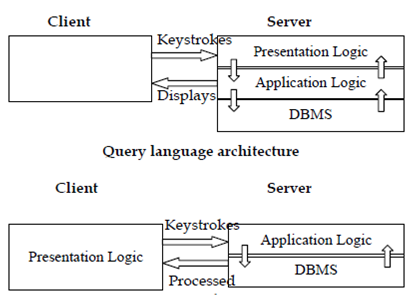Client-Server Architecture
Client or server computing uses local processing power-the power of the desktop platform. An easy definition of client or server computing is which server software requests for data from client manipulates the data and presents the results to the user or acting as a server and sends the results to the client which requested it. In the technical language: most of the application processing is done on a programmable desktop computer that gets application services from another computer in a master or slave configuration.
The emphasis of client/server computing is not hardware. The hardware parts have been around for quite a though. Therefore the hardware does indeed deserve some attention, the main focus of this book will be the technology which makes client/server computing possible- the software.
Client/server computing gives IS (Information Systems) professionals with options through permitting applications to be segmented into tasks. Every task can be run on a different platform and under a different operating system and with a different network protocol. Every task can be maintained and developed separately, accelerating application development. The Data should be placed closer to the user and users can access their data with a comfortable interface and tools for manipulating in which data into meaningful information. Suddenly users are able to do more for them and rely less on Information Systems for assistance and receive quick turnaround time for applications requested of Information Systems. The end result is more efficient use of existing equipment and increased effectiveness of future spending and more productive workers.
Application processing performed on more than one machine in a network should be either cooperative processing or distributed computing. The Distributed computing partitions the data among two or more computers that may be geographically dispersed. The user has access the transparency of the data. The Cooperative processing splits an application’s functions among two or more computers in a peer-to-peer relationship. Most client or server network structures are based on distributed access and not distributed computing. Client or server architecture uses a master or slave configuration where processing may be performed through both the slave and the master.
The use of open systems (software, hardware, networks, operating systems, and databases) enhances client or server computing. Through adhering to standards, open hardware and software can gives portability and interoperability. Open systems offer Information Systems greater flexibility in linking divergent technologies. Therefore, in some cases there are multiple standards and in others none at all.
Although this new technology seems very straightforward, it is really more complex than the technology it is replacing. Still if all the pieces adhere to standards, multiple components must be managed and integrated. The network and all its nodes are treated as the computer. The Department LAN-based systems become category of the enterprise-wide network. Before modifications are made to departmental systems, impact on the enterprise-wide system must be resolved and identified.
Before an organization ventures into the world of client or server computing and an application’s functions that should be reviewed. These breakdowns parallel the division of duties in client or server computing.

Original Client/server applications
Client Processed SQL Server
